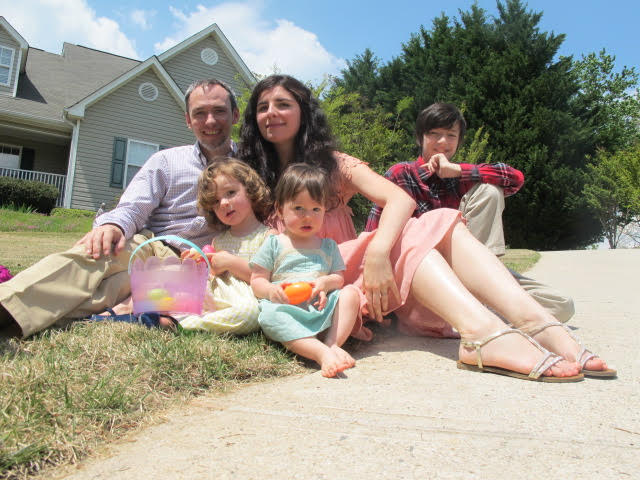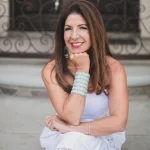
Born Natalia Perez Uribe, Natalia DuTeau is widely known in social media as #thebilingualmami. She is mom to two toddler girls and stepmom of a teenage boy. Natalia was born in Colombia and has lived in the US since 2003. Before that, she lived in various countries and grew up multicultural. She is passionate about everything bilingual and multicultural, and truly believes in the power of raising bilingual/multicultural children to help change the world!
Natalia has a master’s degree in Education with an emphasis in International Educational Development – Language, Literacy and Technology – from Teacher’s College in NYC. She has been working with language education since 2006 and has teaching experience ranging from elementary school level, to high school, to teaching at Latino immigrants centers, and adult education. She recently decided to stay at home with her children and started The Bilingual Mami to help other families raise bilingual children through social media.
Here is my interview with this young, dedicated bilingual Latina mom.
MB: Where were you born and raised? When did you come to the U.S.?
ND: I was born in Bogota, Colombia, but I was raised in several countries in Latin America. However the two countries I lived in for the longest time were Colombia and Argentina. I came to the U.S. in 2003.
MB: Were you raised bilingual and bicultural?
ND: I was raised bilingual. We moved to Buenos Aires when I was 10 years old, and there I entered and International School with children from all around the world. There, I began my bilingual adventure. I had to learn English very quickly because there were 20 different languages spoken by each child at home so the common language at school was English. When I got there I barely knew any English; it was very difficult for me to make friends and I was very behind in all my classes. They put me in ESL and a class for kids with learning disabilities to help me catch up. By the time I was in 9th grade I was fluent in both languages!
I was raised multiculturally. I ended up staying at this international school from 5th grade to 12th grade! Children from all across the globe surrounded me. This exposed me from a very early age to different languages, different religions, and different ways of viewing the world. However, since I was living in Argentina while my family was from Colombia, these two cultures are the strongest for me.
What about your children, are you raising them with two languages and two cultures?
ND: I am raising my children bilingual and multicultural. I am raising them to know they come from Colombia, and I share with them everything that is in my heart, a whole mingle of cultures in a pot. Language is a big part of that. It is important to me when they do go to Colombia, that they will be able to fully submerse themselves in that culture. I may not be able to transmit my culture fully to them, but I can transmit the tools so they can absorb a new culture themselves. This starts with the language, and then with a mind and a heart that is open to welcome aspects of other cultures into your being! To me this is real multiculturalism.
MB: You are a Spanish teacher and also a mom. How did you decide to start The Bilingual Mami?
ND: I decided to start #thebilingualmami because I got tired of living a half-hearted life and decided to start living the passions of my heart! I always had this dream of starting a bilingual school. I began to teach Spanish classes in my living room, and I started to use social media to help other families raise bilingual kids. I realized that in today’s world, with technology, I didn’t need to make a huge investment to start something new. I could do it from my home on my smart phone! I started connecting with other bilingual families, getting ideas, learning from others. I switched my private Instagram account to a public one and I designed a curriculum and began to follow it with my girls at home. I now get to live my dream of helping families raise bilingual children through education and support. Right now, I may not have a physical school/center, but I have a virtual one via Instagram, and this is my joy!
MB: In addition to Facebook posts, you have a YouTube channel. Tell us about that.
ND: I wanted to create a space where I could post my activities, music videos, pronunciation, etc. that people could watch and do at home. For some of these you need a little longer than a minute so you can get the idea and replicate it with your family.
Especially, the MAIN reason I started my Youtube page was to post the longer videos from an initiative I started called #sharingsaturday where bilingual families from around the world share their experience raising bilingual kids. When I started this journey I had NO CLUE what I was doing, I felt alone, worried, lost. I knew NO ONE around me raising bilingual kids. I only went with it because it was important to me, but I had no idea if it would work or not. I took a leap of faith. With #sharingsaturday, we get to meet EVERY WEEK a family that is doing it in their own particular way. This sharing is inspiring, this gives us hope, and it gives us ideas. By seeing different families each week, eventually you are going to meet a family that you can relate to. You are going to feel less intimidated by bilingualism and to feel empowered to doing it.
MB: How do you come up with ideas for your weekly videos?
ND: Every few weeks I plan a unit (similarly as I would do when I used to be a teacher). I use a method called “Backwards Design” to plan my curriculum, in which I start by setting goals before choosing instructional methods and forms of assessment. For example right now we are learning about emotions, so when I designed this unit, I though to myself: “why should we learn about emotions? What exactly do I want them to learn”? Usually, I plan my units with two sides, the thematical side and the language side. I believe that languages are not just dead words to be memorized; they fit inside of a context that is relatable to our life. So if we are going to learn about emotions, its not just about memorizing the emotions vocabulary, the best way to learn it is for it to naturally knit itself within our life. So basically, I select my theme goals and my language goals, and then I plan the activities that will help me to reach these.
MB: Do you believe music is a good way to teach language? Tell us about that.
ND: YES!!! It’s fun, it’s catchy, you can dance to it, and it breaks the ice I LOVE IT! Besides, to learn a new language you need to be silly, if you are perfect you will be too scare to make mistakes and you wont take the risk to just try to say things, even if they come out wrong. Music brings out the silliness in us, the inner child that is locked up! For kids, music helps them to retain new vocabulary because the rhythm and the sounds dig it into their brain. The music makes kind of like a spider web in there, and strange words that normally would enter through one ear and exit through the other, stay stuck and tangled inside that musical spider web!!! IT’S THE BEST!
MB: What is your favorite bilingual activity you do with your children?
ND: Singing and dancing.
MB: Favorite bicultural activity?
ND: Traveling (when possible) and if it’s not possible, going to authentic restaurants/bringing in multicultural food.
MB: How do you find a balance between your work and family life?
ND: Although I quit my teaching job, I’m still a speaker and I go to most of our local high schools once each semester. When I do, my mother in law takes care of my girls. But honestly, for me my #1 job is being a mom and being present for my family. My page, designing my curriculums, etc., all that I do while I live my daily life, while I cook, while I play with my girls, as I’m falling asleep. Posting, writing, prepping activities, I do while my girls nap or have quiet time. Also, my husband is my #1 fan and he helps me with EVERYTHING.
MB: Who is your favorite age group to teach, young children or older kids? Why?
ND: Older Kids- Teens to be precise. I love this because they are in the time of their life that they are choosing for themselves who they want to become as adults and as members of society. They experience so much pressure from peers, the media, parents, themselves, that it can be confusing, overwhelming and scary. It is a very fragile time in their life and as a teacher you can bring a ray of light, hope, joy… and silliness into the intensity of adolescence… especially if they feel they can trust and relate with you. But in terms of language, teaching teenagers is the hardest, especially if they have never been exposed to it. I also love teaching toddlers because it is very natural and fun; they are so ready for anything your mind creates, there are no limits!!!

MB: What is your message for parents raising children with two or more languages?
ND: Don’t be afraid! Children are little sponges and they will succeed.
Language is the MOST natural thing we have as humans, children are eager to communicate and they will surprise you with how quickly they learn. No, they wont get confused, and if they do, eventually they will work it out. Yes, they may rebel at one point, but don’t give up! The gift of bilingualism is the BEST gift you can give a child… financially, sociably, intellectually, emotionally, and psychologically…
Don’t give up, and connect with other multilingual families. Our world NEEDS little bilingual/bicultural people who can switch back and forth between cultural groups and help to bridge these different realities.
@TheBilingualMami, I share your passion! There is no better gift for our children than providing them the opportunities to be fluent in two or more languages and to appreciate multiple cultures.
How is your bilingual journey going? Do share!
Bai, Bai,
Maritere

